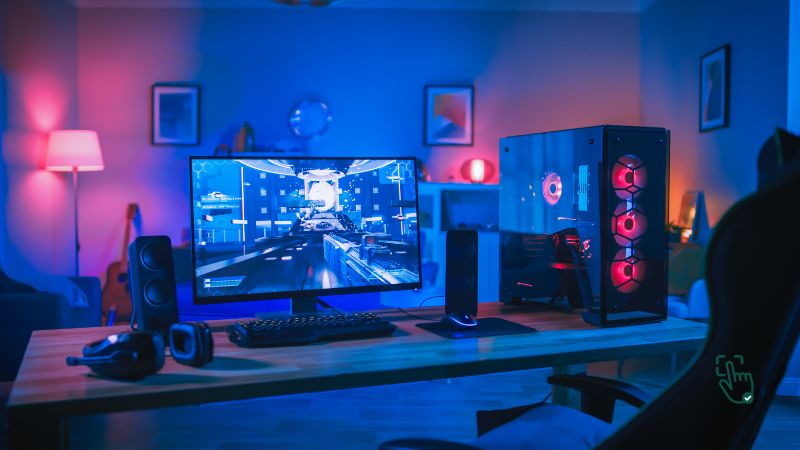
If you’re serious about gaming, you’ve probably heard the buzz about QHD gaming monitors. But what exactly makes them stand out? Whether you’re chasing crystal-clear visuals, smoother gameplay, or just want an upgrade from your old Full HD screen, a QHD gaming monitor might be your next big investment. Let’s dive into everything you need to know about these monitors, their perks, and why they’re perfect for gamers.
QHD gaming monitors offer sharper visuals, smoother frame rates, and a balanced price-to-performance ratio, making them ideal for immersive gaming experiences.
What Is a QHD Gaming Monitor?
A QHD (Quad High Definition) gaming monitor has a resolution of 2560 x 1440 pixels, offering four times the resolution of a 720p screen and a noticeable upgrade from 1080p (Full HD). It’s the sweet spot between FHD and 4K, giving you enhanced clarity and detail without the hefty hardware requirements of 4K gaming.
Why Go for a QHD Gaming Monitor?
Still debating whether it’s worth the upgrade? Here are some reasons why gamers are raving about QHD monitors:
- Sharper Graphics
With more pixels on the screen, QHD offers crisp, clear visuals that make every detail pop, from character textures to in-game landscapes. - Better Performance
Unlike 4K monitors, which demand top-tier GPUs, QHD monitors strike a balance between performance and visual quality. - Wider Screen Real Estate
Enjoy more screen space for multitasking or immersive gaming without jumping to ultra-wide monitors. - Future-Proofing
As game developers push for better visuals, QHD ensures your setup stays relevant for years to come.
Best QHD Gaming Monitors to Consider
If you’re looking to level up your gaming setup, a QHD (2560 x 1440) monitor is the sweet spot between Full HD and 4K. You get sharper visuals without the insane GPU demands of 4K gaming, making it perfect for competitive and immersive gameplay. But with so many options, which one should you pick? Here’s a rundown of some of the best QHD gaming monitors available, each offering something unique for different kinds of gamers.
1. ASUS ROG Swift PG279Q – The High-End Performer
For serious gamers who want top-tier performance, the ASUS ROG Swift PG279Q is a beast. This 27-inch QHD monitor comes with an IPS panel that delivers stunning color accuracy and wide viewing angles, making everything from fast-paced FPS games to rich, open-world adventures look incredible. With a 165Hz refresh rate and G-Sync compatibility, you get ultra-smooth gameplay with minimal screen tearing—perfect for competitive gaming.
Now, the pros: The color accuracy is next level, making this a great choice for both gaming and content creation. The 165Hz refresh rate gives you a serious edge in fast games, and the build quality screams premium. The G-Sync support ensures silky smooth performance, especially if you’re running an NVIDIA GPU.
But no monitor is perfect, and the ASUS ROG Swift PG279Q does have some downsides. First off, it’s expensive. If you’re on a budget, you might want to look at other options. Also, while it technically supports HDR, don’t expect mind-blowing results—it’s a bit underwhelming compared to high-end HDR displays. Still, if you want one of the best gaming monitors on the market, this one won’t disappoint.
Recommended Product: ASUS ROG Swift PG279Q
✔️ 165Hz refresh rate for buttery smooth gameplay ✔️ G-Sync for tear-free gaming ✔️ Amazing color accuracy and wide viewing angles
2. Dell S2721DGF – The Best Bang for Your Buck
If you want a high-performance gaming monitor without breaking the bank, the Dell S2721DGF is an excellent choice. It features a 27-inch IPS panel with a 165Hz refresh rate, meaning you get super-smooth visuals whether you’re fragging enemies in Call of Duty or racing in Forza Horizon. This monitor supports FreeSync Premium, and it’s also G-Sync compatible, making it a great option for both NVIDIA and AMD users.
One of its biggest selling points is the fantastic price-to-performance ratio. You’re getting vibrant colors, great motion handling, and low input lag—all at a much more affordable price compared to high-end monitors. It’s also got solid build quality, and the stand is fully adjustable, which is always a plus.
Now, onto the cons. The contrast ratio is a bit underwhelming, which means blacks won’t look as deep as they do on a VA panel. If you play a lot of dark, atmospheric games, you might notice this. However, for competitive gaming, the fast response time and high refresh rate make up for it. If you’re looking for a solid QHD monitor that doesn’t cost a fortune, this is the one to go for.
Recommended Product: Dell S2721DGF
✔️ Fantastic price-to-performance ratio ✔️ 165Hz refresh rate with FreeSync Premium ✔️ Excellent motion handling and low input lag
3. LG UltraGear 27GL850-B – The Speed Demon
The LG UltraGear 27GL850-B is all about speed and responsiveness, making it an amazing choice for esports players and anyone who plays fast-paced games. This 27-inch QHD IPS monitor boasts an ultra-fast 1ms response time, meaning ghosting and motion blur are practically nonexistent. With a 144Hz refresh rate, it delivers smooth gameplay that competitive gamers will love.
Another huge selling point? The wide color gamut. Colors pop beautifully on this monitor, making it great for both gaming and media consumption. Whether you’re exploring vibrant fantasy worlds or battling it out in Warzone, everything looks sharp and lifelike. Plus, the thin bezels give it a sleek, modern look that fits well in any setup.
However, it’s not perfect. While it supports HDR, it lacks full-array local dimming, meaning HDR performance is a bit lackluster. It’s also not as bright as some of the more expensive models, which could be a downside if you game in a well-lit room. But if you’re looking for an insanely fast, color-accurate QHD gaming monitor, the LG UltraGear 27GL850-B is a fantastic option.
Recommended Product: LG UltraGear 27GL850-B
✔️ 144Hz refresh rate with a 1ms response time ✔️ Wide color gamut for vibrant visuals ✔️ Sleek design with ultra-thin bezels
What to Look for in a QHD Gaming Monitor
Before you hit that “Buy Now” button, here’s what you need to consider:
1. Refresh Rate
The higher the refresh rate, the smoother the gameplay. Aim for at least 144Hz, but if you’re a competitive gamer, 165Hz or higher is ideal.
2. Response Time
Low response times (1ms or less) ensure minimal ghosting or motion blur during fast-paced action.
3. Panel Type
- IPS (In-Plane Switching): Best for color accuracy and wide viewing angles.
- TN (Twisted Nematic): Great for competitive gaming due to faster response times.
- VA (Vertical Alignment): Known for deeper blacks and better contrast.
4. Adaptive Sync Technology
Look for G-Sync (for NVIDIA GPUs) or FreeSync (for AMD GPUs) to eliminate screen tearing and stuttering.
5. HDR Support
HDR enhances the contrast and color range, making games look more realistic.
6. Build Quality and Ergonomics
Adjustable stands, slim bezels, and durable materials make a big difference in user experience.
Are There Any Downsides to QHD Monitors?
While QHD monitors are fantastic, they’re not without drawbacks:
- Higher Hardware Demands:
Running games at QHD resolution requires a decent GPU. Budget builds may struggle to maintain high frame rates. - Price Point:
While cheaper than 4K, QHD monitors are pricier than FHD. - Limited for Casual Users:
If you’re not into competitive gaming or immersive visuals, a QHD monitor might be overkill.
QHD vs. 4K: Which One Should You Choose?
If you’re torn between QHD and 4K, here’s a quick comparison:
| Feature | QHD | 4K |
|---|---|---|
| Resolution | 2560 x 1440 | 3840 x 2160 |
| Performance | Easier on mid-tier GPUs | Requires high-end GPUs |
| Price | More affordable | Expensive |
| Gaming Experience | Great for most gamers | Ideal for cinematic experiences |
For most gamers, QHD hits the perfect balance of performance and visuals without burning a hole in your pocket.
Frequently Asked Questions About QHD Gaming Monitors
1. Is a QHD monitor worth it for gaming?
Absolutely! It offers sharper visuals and a better gaming experience than FHD while being less demanding than 4K.
2. Can my PC handle a QHD monitor?
If you have a mid-range GPU like the NVIDIA RTX 3060 or AMD RX 6600 XT, you should be able to run most games at QHD smoothly.
3. Are QHD monitors good for productivity?
Yes, the extra screen real estate is excellent for multitasking, photo editing, and even streaming.
Conclusion: Is a QHD Gaming Monitor Right for You?
If you want sharper visuals, smoother gameplay, and a future-proof setup, a QHD gaming monitor is an excellent choice. It’s the perfect middle ground between FHD and 4K, offering the best of both worlds without the extreme price or performance demands. Whether you’re a casual gamer or an esports enthusiast, there’s a QHD monitor out there that fits your needs and budget.



